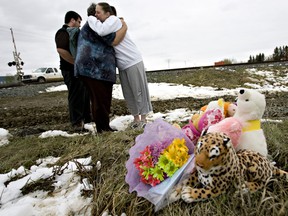The 24-day civil trial was scheduled to begin on Monday

Article content
A lawsuit filed by an Edmonton woman following the 2010 deaths of her husband and their two children at railway crossing has been settled out of court.
advertisement 2
Article content
Alana Baxter sued Via Rail, Canadian National Railway, train operators and the City of Edmonton for $11 million.
A 24-day civil trial was scheduled to begin Monday at Alberta Court of Queen’s Bench in Edmonton, but a court spokesperson told Postmedia that the parties reached a settlement over the weekend.
Details of such settlements are typically protected from publication by non-disclosure agreements.
Efforts to contact Baxter were unsuccessful.
John Baxter42, was driving his two daughters, Julianne, 9, and Coral Sky, 7, to school amid a snowstorm on the morning of May 4, 2010.
The three died just after 8:30 am when the Chevrolet Silverado truck they were in collided with a Via passenger train bound for Vancouver from Toronto at Winterburn Road north of 111 Avenue.
advertisement 3
Article content
No injuries were reported among the 26 crew members and 219 passengers on board the train.
The crossing was protected by a bell, gates, and incandescent flashing lights.
But, the Transportation Safety Board investigated and found that heavy, wet snow had accumulated on the warning signals, gates, light and reflectors.
The board says Baxter likely didn’t see the signal lights and that the crossing gate was down until his vehicle was too close to stop due to road conditions.
“Visibility of the active crossing protection system was greatly reduced and road conditions were made slippery by the severe weather conditions,” the 2011 report into the deaths states.
The TSB’s report found the truck had entered the crossing and the impact of the collision propelled the vehicle into a ditch about 150 feet away.
advertisement 4
Article content
The report found the train was traveling at just over 110 km/h at the time of the crash and took 40 seconds to fully stop, traveling a further 700 feet in that time.
It found that the driver was not wearing his seatbelt at the time of the collision and the truck’s airbags did not deploy.
At the time of the crash, the temperature was near zero degrees with winds gusting close to 70 km/h with blowing and falling snow, according to the TSB report.
Investigators also noted it had rained throughout the night before, which turned into freezing rain and then later into snow as the temperature dropped.
The snow and ice covered the signals, muting the sound of the warning bell, investigators found.
Close to 17 centimeters of snow eventually fell that day, according to weather records.
Two weeks after the crash, Canadian National Railway replaced the crossing protection system with a constant warning system with LED lights.
The board noted that crossing did not require train whistles to be blown — the city of Edmonton passed an anti-whistling bylaw for the crossing and applied to Transport Canada to stop the whistling, which was granted in 1989.